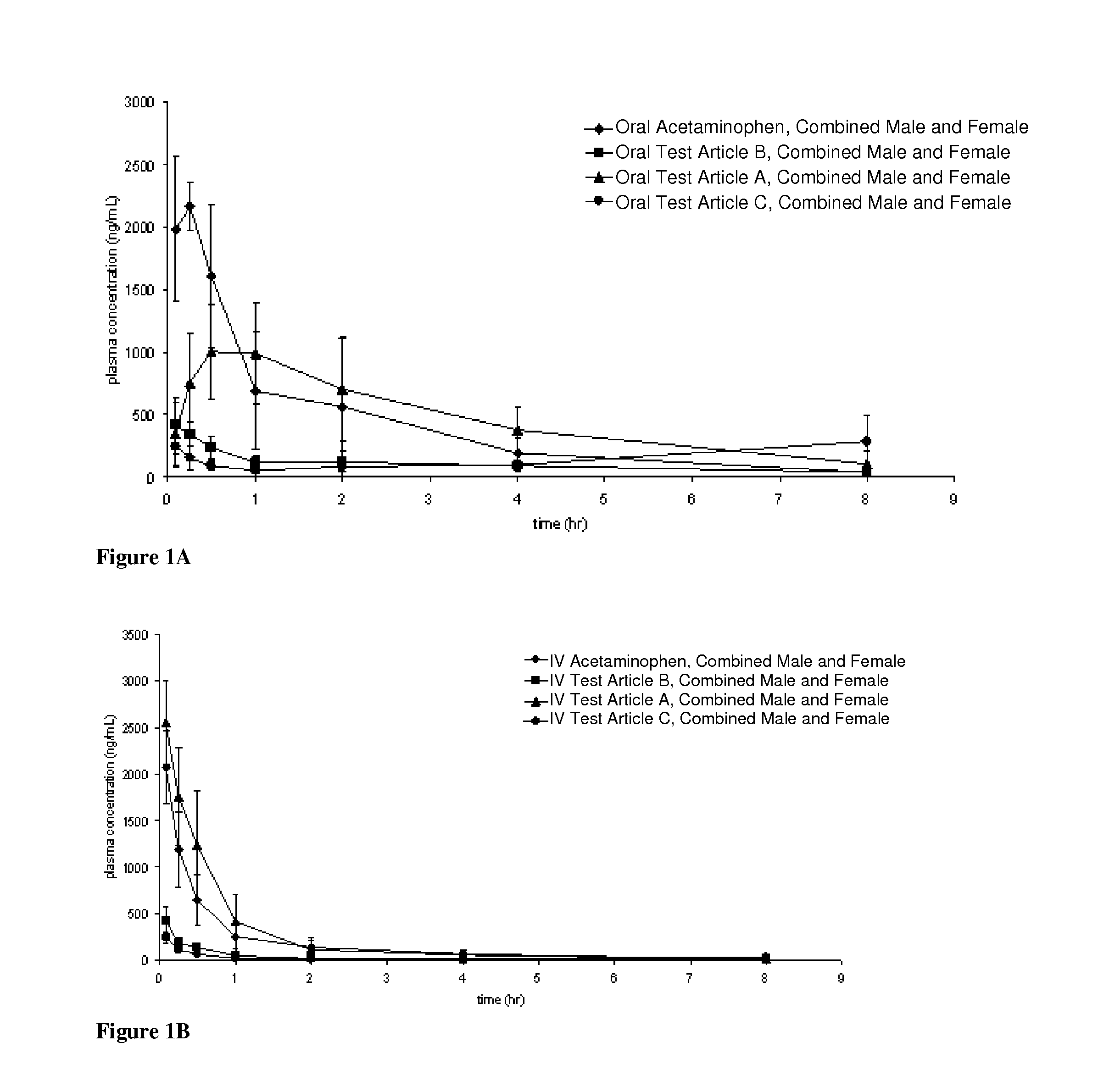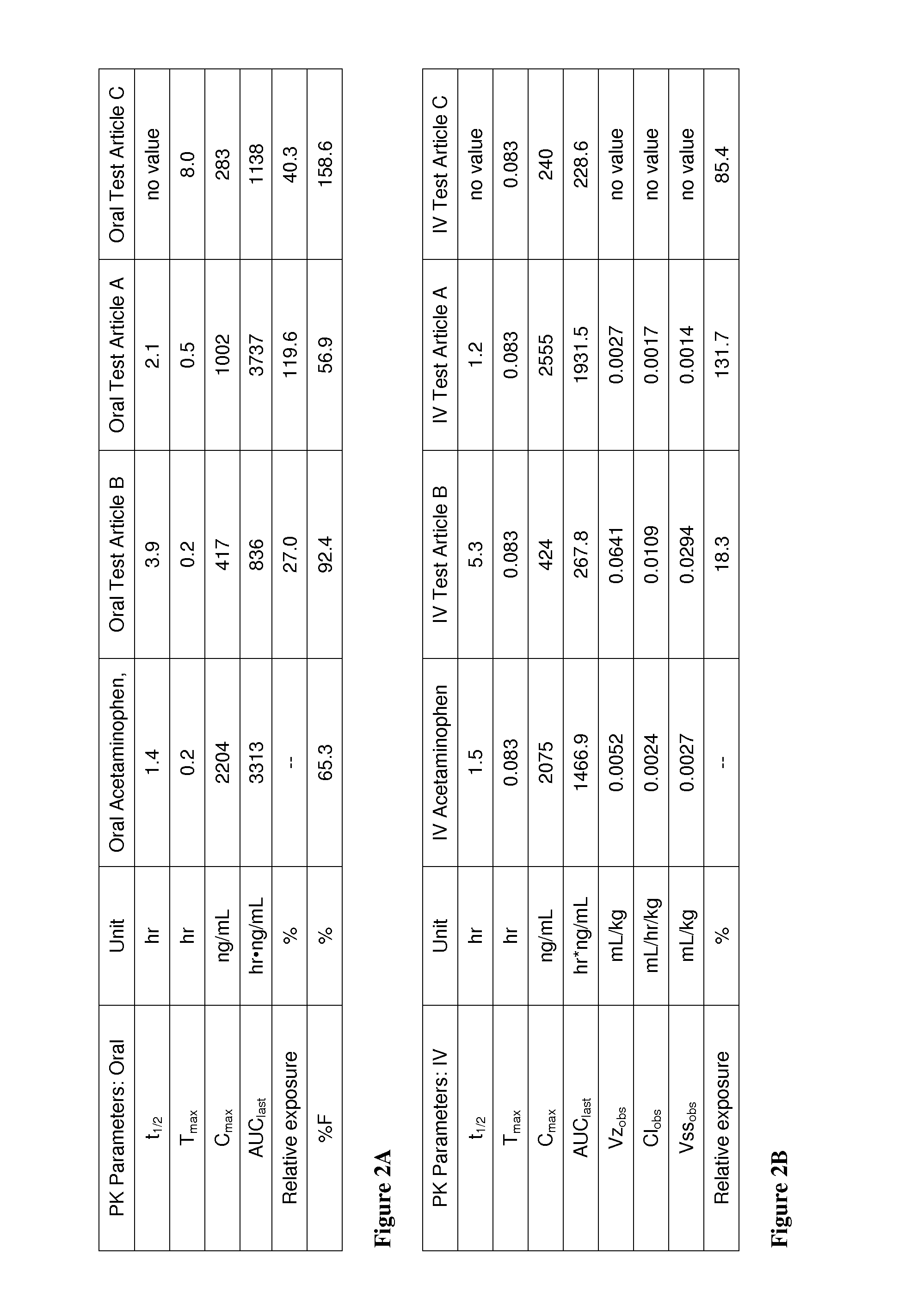Acetaminophen conjugates, compositions and methods of use thereof
a technology of acetaminophen and conjugates, applied in the field of acetaminophen conjugates, compositions and methods of, can solve the problems of inability to acetaminophen to be toxic to the liver, inability to clot, and inability to clot, so as to improve the safety of acetaminophen consumption, rapid onset of acetaminophen action, and the effect of more predictable and/or normalized
- Summary
- Abstract
- Description
- Claims
- Application Information
AI Technical Summary
Benefits of technology
Problems solved by technology
Method used
Image
Examples
example 1
Synthesis of 4-Acetamidophenyl 4-nitrophenyl carbonate (3)
[0132]
[0133]Adapting a known procedure (P. Pasetto, et al., Anal. Chim. Acta, 2005, 542(1), 66-75), 8.03 mL of anhydrous pyridine (7.84 g, 99.3 mmol; 1.5 eq.) was added at a temperature of about 0° C. (ice bath) to a suspension of 10.00 g N-(4-hydroxyphenyl)acetamide (1) (paracetamol (INN), acetaminophen (USAN) (66.2 mmol; 1.0 eq.) in 300 mL of anhydrous dichloromethane (DCM). The reaction mixture was stirred at the same temperature for about 10 minutes. To this mixture, a solution of 13.97 g (69.5 mmol; 1.05 eq.) of commercially available 4-nitrophenyl carbonochloridate (2) in 20 mL of anhydrous DCM was then added dropwise and the reaction mixture was stirred with gradual warming to room temperature for overnight. Fifty (50) mL of water were added to the reaction mixture. A solid precipitated out of solution. The solid was filtered off and washed successively with diethylether (Et2O) (2×50 mL) and hexane (4×50 mL) to afford ...
example 2
Synthesis of Sodium 2-aminoethanesulfinate (5)
[0134]
[0135]Sodium 2-aminoethanesulfinate (5) was prepared according to the General Procedure for the Preparation of Alkali Metal Salts (Procedure A). 2-Aminoethanesulfinic acid (hypotaurine) (4) (350 mg, 3.21 mmol) was dissolved in 2 mL of degassed water and reacted with 3.21 mL (3.21 mmol) of a 1.0 N aqueous sodium hydroxide solution (NaOH(aq.)) (1.0 eq.). The reaction mixture was degassed through repetitive vacuum / nitrogen purge cycles and was heated to about 55° C. for about 30 minutes. The reaction mixture was frozen and the solvent was removed through lyophilization to yield 410 mg (97% yield) of the target material 5 as a colorless solid. 1H NMR (300 MHz, D2O): δ 2.75 (t, J=6.6 Hz, 2H), 2.29 (t, J=6.9 Hz, 2H) ppm. The analytical data corresponded to the analytical data given in the literature and the proposed structure.
example 3
Synthesis of Sodium 2-aminoethanesulfonate (7)
[0136]
[0137]Sodium 2-aminoethanesulfonate (7) is commercially available and was also prepared according to the General Procedure for the Preparation of Alkali Metal Salts (Procedure A). 2-Aminoethanesulfonic acid (taurine) (6) (1.0 g, 8.0 mmol) was dissolved in 8 mL of water and was reacted with 320 mg (8.0 mmol; 1.0 eq.) of solid sodium hydroxide (NaOH) at 60° C. with sonication. The reaction mixture was frozen and the solvent was removed through lyophilization to yield 1.0 g (˜quantitative yield) of the target compound 7 as a colorless solid. 1H NMR (300 MHz, D2O): δ 2.90-2.80 (m, 4H) ppm. The analytical data corresponded to the analytical data given in the literature and the proposed structure.
PUM
| Property | Measurement | Unit |
|---|---|---|
| Pharmaceutically acceptable | aaaaa | aaaaa |
Abstract
Description
Claims
Application Information
 Login to View More
Login to View More - R&D
- Intellectual Property
- Life Sciences
- Materials
- Tech Scout
- Unparalleled Data Quality
- Higher Quality Content
- 60% Fewer Hallucinations
Browse by: Latest US Patents, China's latest patents, Technical Efficacy Thesaurus, Application Domain, Technology Topic, Popular Technical Reports.
© 2025 PatSnap. All rights reserved.Legal|Privacy policy|Modern Slavery Act Transparency Statement|Sitemap|About US| Contact US: help@patsnap.com



